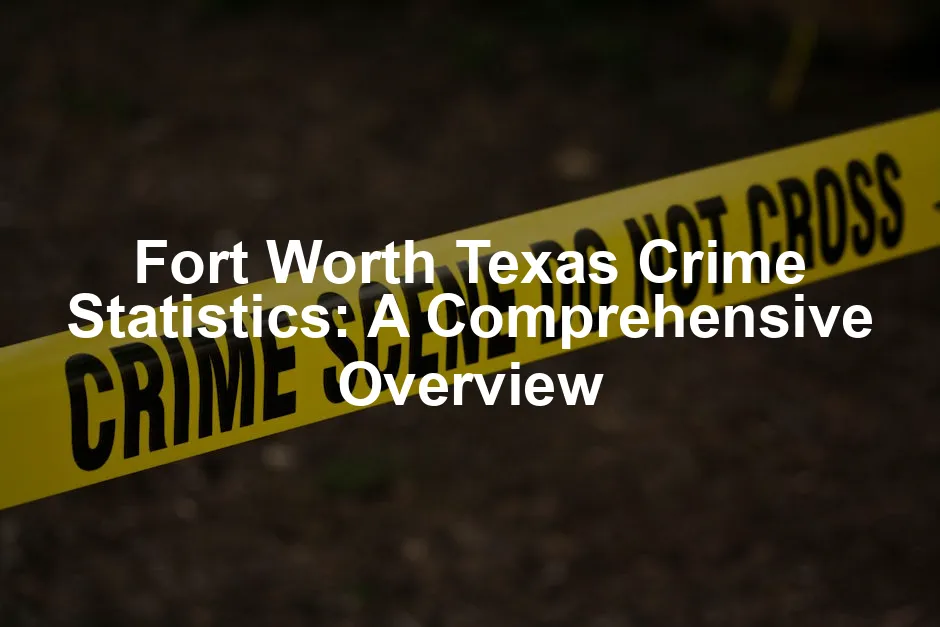Introduction
Understanding crime statistics in Fort Worth, Texas, is crucial for various reasons. For residents, knowledge about safety can shape daily decisions. Potential movers may weigh crime rates when choosing a neighborhood. Policymakers can use these statistics to implement effective strategies for crime reduction and community safety.
Fort Worth, a vibrant city nestled in Tarrant County, has seen fluctuations in crime rates over the years. As of 2023, the overall crime rate stands at 32 per 1,000 residents, which is notably higher than many communities nationwide. In fact, a staggering 91% of Texas communities report lower crime rates than Fort Worth. This statistic should raise eyebrows and prompt discussions about safety and security.
The violent crime rate is reported at 5 per 1,000 residents, while property crime is more prevalent at 27 per 1,000 residents. These figures highlight the ongoing challenges the city faces. Understanding these statistics is not just about numbers; it’s about real lives affected. The purpose of this article is to analyze crime statistics, highlight trends, and provide insights into neighborhoods and safety perceptions throughout Fort Worth.
By examining the crime landscape, residents can better understand the risks and prepare accordingly. Potential movers gain insights into the safety of their future homes. Meanwhile, policymakers can utilize this information to allocate resources effectively. So, buckle up as we navigate through Fort Worth’s crime statistics, trends, and neighborhood safety perceptions!

Overview of Crime in Fort Worth
Current Crime Rates
Fort Worth’s crime rates present a compelling narrative. With a total crime rate of 32 per 1,000 residents, it’s clear that safety is a pressing concern. In comparison, the Texas average hovers around 23 per 1,000, making Fort Worth stand out for all the wrong reasons. NeighborhoodScout reports that the chance of becoming a victim of crime in Fort Worth is about 1 in 31. This is an alarming statistic.
When breaking down the numbers, the violent crime rate in Fort Worth is about 5 per 1,000 residents. This translates to a 1 in 201 chance of falling victim to a violent crime. In contrast, property crime rates soar to 27 per 1,000 residents, giving you a 1 in 37 chance of being affected. It’s essential to understand these statistics in context. They reflect not just numbers but the safety and well-being of Fort Worth residents.
Sources like AreaVibes and NeighborhoodScout provide further insights. The overall crime in Fort Worth is 39% higher than the national average, with violent crimes being 36% higher. Property crimes sit at a staggering 40% above the national average. These figures should not only alarm residents but also spark conversations about community safety and law enforcement effectiveness.

Speaking of community safety, have you considered enhancing your home security? A Home Security Camera System can provide peace of mind, allowing you to monitor your property remotely. Knowing that you have eyes on your home can help alleviate some of that worry!
Key Crime Metrics
Now let’s take a closer look at the specifics. Fort Worth’s violent crime includes various categories:
- Murder: 100 incidents (0.10 per 1,000 residents)
- Rape: 591 incidents (0.62 per 1,000 residents)
- Robbery: 689 incidents (0.72 per 1,000 residents)
- Assault: 3,388 incidents (3.54 per 1,000 residents)
On the property crime side, the numbers are equally striking:
- Burglary: 4,003 incidents (4.18 per 1,000 residents)
- Theft: 18,541 incidents (19.38 per 1,000 residents)
- Motor Vehicle Theft: 3,558 incidents (3.72 per 1,000 residents)
These metrics show a vivid picture of crime in Fort Worth. They highlight a significant disparity between violent and property crimes. With property crimes making up a larger share, residents must remain vigilant. Understanding the nuances of these statistics helps in grasping the complexities of safety in Fort Worth. As we continue, we will further dissect the crime landscape, examining trends and perceptions that shape this dynamic city.

For a detailed understanding of crime trends, check out this article on fort worth crime statistics.
Breakdown of Violent Crimes
Types of Violent Crimes
Fort Worth grapples with several types of violent crimes that can make even the bravest soul look over their shoulder. Let’s break down the numbers, shall we?
- Murder: With 100 incidents reported, Fort Worth’s murder rate stands at 0.10 per 1,000 residents. While it’s a grim statistic, it’s essential to remember that every number here represents a life affected.
- Rape: This is a particularly harrowing category, with 591 incidents, translating to 0.62 per 1,000 residents. The community must come together to support survivors and foster an environment where people feel safe to report these crimes.
- Robbery: With 689 incidents (0.72 per 1,000 residents), robbery contributes significantly to Fort Worth’s crime landscape. Often fueled by economic factors, it’s a reminder that prevention and community support systems are vital.
- Assault: The most prevalent violent crime in Fort Worth, assault incidents hit a staggering 3,388, which equates to 3.54 per 1,000 residents. This signifies a need for awareness and perhaps a dash of self-defense classes for the community!
So, what do these numbers really tell us? They paint a pretty vivid picture that violent crime, while concerning, can be addressed through community engagement and support systems. Education and outreach can help reduce these statistics and create a safer environment for all.

And speaking of self-defense, why not consider a Pepper Spray for Self-Defense? It’s a small yet powerful tool that can give you a sense of security when you’re out and about. A little preparation can go a long way!
Geographic Distribution
Now, let’s wander through the neighborhoods of Fort Worth and see where these violent crimes are most concentrated. Certain areas, unfortunately, seem to attract more trouble than others.
Neighborhoods like Southside and Southeast Fort Worth often report higher rates of violent crimes. These areas are frequently in the spotlight for both their vibrant culture and their crime challenges. Residents express mixed feelings about safety. Some feel secure in their homes, while others remain on high alert, especially during the night.
Community perceptions vary widely. According to surveys, about 43% of residents feel secure, while a significant 57% express apprehension, particularly after dark. This disparity highlights the need for community engagement with law enforcement and local organizations to bolster safety measures.
The good news? Community initiatives and increased police presence in key areas can help mitigate fears and improve safety perceptions. Residents are encouraged to report suspicious activities and engage in neighborhood watch programs. Remember, safety isn’t just a personal responsibility; it’s a community effort!

Breakdown of Property Crimes
Types of Property Crimes
Property crimes in Fort Worth are a different beast, and they come with their own set of statistics that can make your head spin. Let’s dive into the details:
- Burglary: With 4,003 incidents reported, the burglary rate stands at 4.18 per 1,000 residents. This means home and business owners need to step up their security game with good locks, alarms, and perhaps a nosy neighbor or two.
- Theft: Now, this is where the numbers really start to climb! A whopping 18,541 incidents of theft are reported, giving a rate of 19.38 per 1,000 residents. Theft can range from petty shoplifting to more serious crimes, affecting the community’s overall sense of safety.
- Motor Vehicle Theft: With 3,558 incidents, the rate is 3.72 per 1,000 residents. This crime can be particularly distressing for car owners, leading to feelings of vulnerability.
These statistics indicate that property crime is a significant issue in Fort Worth, and residents should take proactive measures to protect their belongings.

To enhance your safety, consider a Door Lock Security System. Investing in a reliable locking system can significantly reduce your risk of burglary, allowing you to sleep soundly at night.
Geographic Distribution
When it comes to geographic distribution, certain neighborhoods are hit harder by property crimes. Areas like the Far Southwest and parts of Downtown see higher incidences of theft and burglary. Residents in these neighborhoods often share their concerns about safety, especially regarding their homes and vehicles.
According to community sentiment, many feel that property crime affects their overall sense of security. A survey revealed that 48% of residents worry about home burglaries, while 35% fret about vehicle theft. These worries are valid, considering the statistics we’ve just outlined.
Despite these challenges, residents can take steps to enhance their safety. Simple actions like installing security cameras, participating in neighborhood watch programs, and being vigilant can make a huge difference. Remember, safety is a shared responsibility. By fostering a sense of community and working together, Fort Worth can tackle its property crime challenges head-on.
In conclusion, understanding the violent and property crime landscape in Fort Worth is crucial for residents, potential movers, and policymakers alike. With shared efforts and proactive measures, there’s hope for a safer tomorrow!

Comparison with State and National Averages
Crime Rate Comparisons
Fort Worth’s crime rates certainly raise eyebrows. The city’s total crime rate is 32 per 1,000 residents, which is significantly higher than the Texas average of 23 per 1,000 and the national average of 22 per 1,000. This means that Fort Worth is not just a little off the charts; it’s doing its own wild dance in the crime statistics arena.
Take a gander at the table below for a clearer picture:
| Crime Type | Fort Worth | Texas Average | National Average |
|---|---|---|---|
| Total Crime | 3,242 incidents | 2,732 | 2,324 |
| Violent Crime | 502 per 100k | 432 | 370 |
| Property Crime | 2,740 per 100k | 2,300 | 1,954 |
| Murder | 10.5 per 100k | 6.7 | 6.3 |
| Rape | 62.3 per 100k | 50.0 | 40.0 |
| Robbery | 72.6 per 100k | 70.5 | 66.1 |
| Assault | 356.8 per 100k | 304.7 | 268.2 |
| Burglary | 420.9 per 100k | 334.3 | 269.8 |
| Theft | 1,943.8 per 100k | 1,634.4 | 1,401.9 |
| Vehicle Theft | 375.0 per 100k | 331.2 | 282.7 |
These numbers tell a story of disparity. Fort Worth struggles with a considerably higher rate of violent crime, standing at 36% above the national average. When we talk property crime, it’s a whopping 40% higher than the nation’s averages. If that doesn’t make you rethink your evening stroll, what will?

Contextual Analysis
So, why does Fort Worth stand out like a sore thumb in these statistics? Several factors contribute to this situation. Socioeconomic conditions play a massive role. With an unemployment rate of 3.9%—which is lower than the national average—it seems counterintuitive; yet, income inequality can lead to higher crime rates. Not everyone feels the same financial security, and desperation can lead to poor choices.
Then, we have law enforcement practices. Fort Worth boasts 2.52 officers per 1,000 residents, which is lower than the national average of 3.25. This lower presence may leave some areas feeling like the Wild West, with criminals running amok. More officers could mean more eyes on the ground, and more safety for the residents.
Community engagement is another essential aspect. When communities band together, they can create a more substantial support network. Programs that foster relationships between law enforcement and residents can lead to better communication and crime prevention strategies. Nothing like a neighborhood BBQ to get the crime-fighting juices flowing, right?
In summary, Fort Worth’s crime rates need to be viewed through a lens that includes socioeconomic factors, law enforcement practices, and community ties. Understanding these nuances provides valuable insight for residents and potential movers alike.

Neighborhood Crime Rates
Overview of Popular Neighborhoods
Fort Worth is a patchwork of neighborhoods, each with its own flavor and safety rating. Here’s a quick rundown of some popular areas and their respective crime rates:
- Montserrat: Known for its picturesque views and upscale homes, Montserrat boasts a lower crime rate, making it a favorite for families.
- Avondale: Vibrant and trendy, Avondale offers lively nightlife but has some crime concerns, particularly property crime.
- Haslet South: This suburban gem provides a safe haven with a low crime rate, perfect for those seeking tranquility.
- Mira Vista: With its gated communities and family-friendly atmosphere, Mira Vista is another low-crime area that residents cherish.
- Pecan Acres: This neighborhood combines charm with safety, making it an attractive option for new families.
- Lake Country: A peaceful retreat with scenic lakes, it’s also known for its low crime rates.
- Eagle Ranch: A growing community, Eagle Ranch sees moderate crime rates but remains a desirable location.
- Pearson Ranch Rd / White Settlement Rd: This area has higher-than-average crime rates, particularly for property crime.
- Heritage Northeast: A mix of residential and commercial properties, it faces some challenges with crime but is actively working to improve safety.
- Villages of Woodland Springs East: Family-friendly with a good reputation for safety, this neighborhood is favored by many.
Not all neighborhoods are created equal. While some shine with their safety stats, others might make you think twice before venturing out alone after dark.

If you want to feel extra secure in your home, consider installing Smart Doorbell Cameras. These nifty devices allow you to see who’s at your door from anywhere, giving you an added layer of protection.
Comparison with Nearby Communities
When looking at nearby communities, Fort Worth’s crime rates often stand in stark contrast. Take Azle, for instance. This small town is known for its friendly atmosphere and low crime rates, making it an appealing alternative for those wary of Fort Worth’s statistics.
Benbrook also has a reputation for being one of the safer suburbs, with property crime rates significantly lower than Fort Worth. Hurst, on the other hand, offers a balanced crime rate that is not as alarming as Fort Worth but also not as tranquil as Azle.
A quick comparison of crime rates between these communities shows that Fort Worth needs to step up its game. While it may have the hustle and bustle of a large city, the crime statistics might make some residents long for the quieter streets of nearby towns.
In conclusion, understanding neighborhood crime rates is crucial for residents and potential movers. By comparing Fort Worth with nearby communities, it becomes clear that safety varies significantly across different areas. Residents can make informed decisions about where to settle down and how to stay safe in their chosen neighborhood.

Community Sentiment on Crime and Safety
Surveys and Polls
Understanding how residents feel about crime and safety in Fort Worth is essential. Recent surveys reveal a mixed bag of sentiments regarding safety in the city. A poll conducted by AreaVibes indicates that 43% of residents feel secure, believing crime is minimal. Conversely, a significant 57% express apprehension, particularly after dark. These statistics highlight a palpable divide in community sentiment.
Breaking it down by neighborhoods can be enlightening. For instance, areas like Montserrat and Haslet South report a higher sense of security. Residents there tend to feel less anxious, thanks to lower crime rates. In contrast, neighborhoods such as Southside and Western Hills-Ridglea often show heightened concerns. Residents in these areas frequently discuss their unease, particularly regarding property crimes.
Community sentiment is critical for understanding how crime impacts daily lives. While some neighborhoods bask in a sense of safety, others are gripped by fear. This disparity underscores the need for targeted community programs aimed at fostering trust and communication among residents and law enforcement.

Law Enforcement and Community Engagement
The role of law enforcement in addressing crime and enhancing community safety cannot be overstated. Fort Worth Police Department has made strides in community engagement, aiming to build trust with residents. According to local reports, police presence is notably higher in areas with increased crime rates, emphasizing a proactive approach to crime reduction.
Data reveals that Fort Worth has approximately 2.52 officers per 1,000 residents, which is lower than the national average of 3.25. This discrepancy may leave residents feeling vulnerable, particularly in high-crime neighborhoods. However, response times have improved, with many residents reporting quicker assistance when emergencies arise.
Engagement initiatives like neighborhood watch programs and community forums offer platforms for residents to voice their concerns and collaborate with law enforcement. These efforts aim to bolster safety and create a more cohesive community. The police department’s visible presence in neighborhoods, particularly during night hours, has also helped reduce crime rates and enhance feelings of safety among residents.
Community sentiment and law enforcement collaboration are vital components in Fort Worth’s ongoing efforts to address crime. While challenges remain, the commitment to building safer neighborhoods through active engagement promises a brighter future for residents.

FAQs
What is the overall crime rate in Fort Worth?
Fort Worth has a crime rate of 32 per 1,000 residents. This figure is significantly higher than the national average, which raises concerns for local residents. The violent crime rate stands at 5 per 1,000, while property crime dominates at 27 per 1,000. What does this mean for you? Well, the likelihood of becoming a victim of crime in Fort Worth is about 1 in 31. It’s a statistic that demands attention, especially for families and individuals considering moving to the area. While some neighborhoods are relatively safe, the overall landscape suggests a need for vigilance when it comes to personal safety and property protection.
How does Fort Worth compare to other major Texas cities?
When comparing Fort Worth to other major Texas cities like Dallas and Austin, the numbers tell a rather startling story. Fort Worth’s total crime rate is approximately 39% higher than the national average, and it is notably higher than Austin’s rates, which are generally lower. In fact, Dallas also has higher violent crime rates, but Fort Worth edges ahead in property crimes. What does this mean for you? If you’re weighing your options between these cities, consider Fort Worth’s higher crime rates and decide if that aligns with your comfort level regarding safety.
What measures are being taken to improve safety in Fort Worth?
The city of Fort Worth is actively working to enhance safety through various programs and initiatives. Local law enforcement has ramped up community engagement efforts, encouraging residents to participate in neighborhood watch programs. These initiatives foster trust and collaboration between police and community members. Additionally, Fort Worth has implemented crime prevention strategies, including increased police presence in high-crime areas. Community programs focus on youth outreach, providing education on the consequences of crime and offering alternatives. Together, these measures aim to create a safer environment for everyone.
Are there specific neighborhoods to avoid in Fort Worth?
Fort Worth, like many cities, has neighborhoods that experience higher crime rates. Areas such as Southside and Southeast Fort Worth often report elevated rates of both property and violent crimes. Residents in these neighborhoods frequently voice concerns about safety, particularly at night. If you’re considering a move, it’s wise to research specific neighborhoods and assess crime statistics. While some areas boast a friendly, community-oriented environment, others may evoke a sense of unease. Always trust your instincts and prioritize safety when choosing a neighborhood.
How can residents stay informed about crime in their area?
Staying informed about local crime is vital for Fort Worth residents. One of the best resources is the Fort Worth Police Department’s website, which provides updates on crime statistics and safety alerts. Additionally, websites like NeighborhoodScout and AreaVibes offer detailed crime reports and neighborhood safety ratings. Social media platforms and neighborhood apps like Nextdoor can also be valuable for real-time updates and community discussions. Engaging with local community forums can provide insights into safety concerns and foster a sense of shared responsibility among residents. Knowledge is power, and staying informed can help you navigate safety in Fort Worth more effectively.
As you consider your safety, don’t forget to keep a First Aid Kit handy. You never know when a little accident might occur, and being prepared can make all the difference.
Please let us know what you think about our content by leaving a comment down below!
Thank you for reading till here 🙂
All images from Pexels




